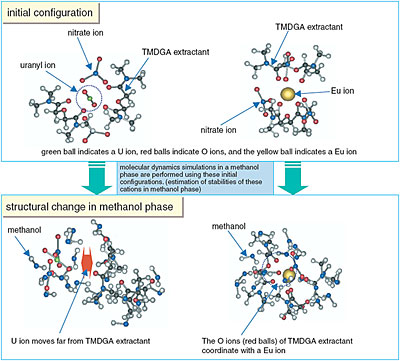Selective separation of U and Pu is required for the effective utilization of nuclear resources. Highly radioactive elements are treated during the reprocessing process. Separation and recovery of these radioactive elements are essential to minimize a burden to environment.
Separation of these radioactive wastes, in general, is carried out by liquid-liquid extraction under highly acidic conditions. In JAERI, we are trying to simulate these separation processes by molecular dynamics using the supercomputer of our institute. In this research, first we calculated the charge density distribution by the ab initio molecular orbital calculation method. We then simulated the molecular dynamics with the TMDGA molecule (one of the diamide type extractants used) and the Eu3+ and UO22+ ions using the charge density distribution obtained previously. Further simulations were also used to estimate the stability of these optimized complexes in the water and methanol phases. We determined that the UO22+-TMDGA complex is unstable in both the water and methanol phases (left side of Fig. 10-4). Eu3+-TMDGA is also unstable in the aqueous phase, however, in the methanol phase the complex is quite stable in this simulation (right side of Fig. 10-4). These results indicate the separation behavior of UO22+ and Eu3+ ions in both phases. The computational approach is becoming an important tool for the evaluation of the chemical behavior of ions in solution.
|
